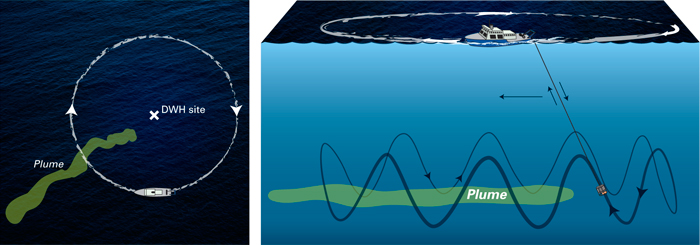|
|

| 1. 1. Tow-yo
The research team searched for evidence of plumes around the Deepwater Horizon riser pipe using a technique called a “tow-yo,” which oceanographers had perfected to search for plumes from hydrothermal vents of the seafloor. To tow-yo, researchers dangle a package of sensors into the ocean from a cable connected to a ship. The ship tows the cable horizontally while a winch alternately hoists the package up and lowers it down again like a yo-yo—in an effort to land the package within a plume. The crew of the research vessel Endeavor circled in a 3.1-mile radius nearly completely around the broken well, skillfully tow-yo-ing instruments between 2,600 and 4,600 feet deep on a mile-long cable in the sea. (Illustration by Jack Cook, Woods Hole Oceanographic Institution) | 2. 2. Sentry
Sensors on the tow-yo confirmed strong petroleum hydrocarbon readings west-southwest of the well site at a depth of about 3,600 feet. Scientists dispatched Sentry, an autonomous underwater vehicle (AUV), to that location, equipped with the TETHYS mass spectrometer to detect chemicals. Sentry zigzagged across the area, with TETHYS detecting where chemicals were and were not. In three dives covering 146 miles between June 23 and 27, Sentry sculpted the shape of the plume. It was more than a mile wide and 600 feet high, and it flowed continuously southwest from Deepwater Horizon at a speed of about 4 miles per day for at least 22 miles. (Illustration by Jack Cook, Woods Hole Oceanographic Institution) | 3. 3. Sampling
The next step was to get samples of seawater directly from the plume to see what chemicals were in it. “We weren’t stabbing arbitrarily hoping to find something,” said WHOI chemist Chris Reddy. “We used a hunter-gatherer strategy: Sentry had hunted for the plume, told us exactly where to look, and we gathered right there within it.” The samples were dispatched to a laboratory and analyzed to look for more than 100 different compounds. The research team’s findings, published in Proceedings of the National Academy of Sciences in July 2011, showed that the plume contained a preponderance of only six petroleum hydrocarbon compounds: benzene, toluene, ethylbenzene, and xylenes. (Illustration by Jack Cook, Woods Hole Oceanographic Institution) | Last updated: July 28, 2014
|


